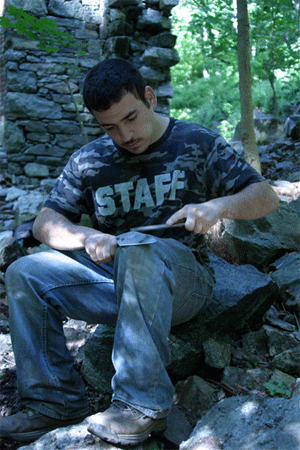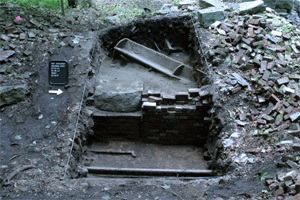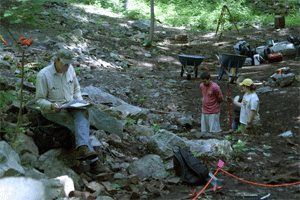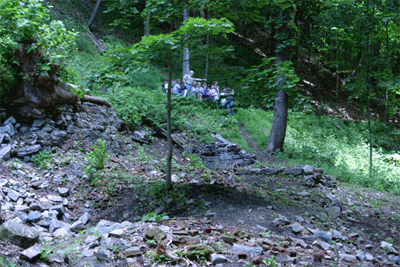
Tom, the author, sharpens up his trowel before more digging.

An early archaeological view of a granite base and cast iron leg for a cupola furnace located in the Moulding Shop Complex.

Meg continues to collect data for a detailed topographic map of the moulding shop.

John pondering paperwork while Dan & Meg examine recent archaeological discoveries in the background.
|
My name is Tom Conte and I am an undergraduate sophomore at Fordham University in the Bronx, New York majoring in anthropology and economics. I enrolled in Michigan Tech’s field school in industrial archaeology to supplement my undergraduate degree with field experience as well as to explore the local history of the Hudson Highlands region and its impact on American History.
The past week at the West Point Foundry has been very exciting because the crew has begun to peel back from our excavation units years of abandonment in order to piece together the history of the foundry’s moulding shop. We have begun to search for a 3x3 meter brick smoke stack that was used to vent hot gasses from two larger cupola furnaces in the shop. A cupola is a larger furnace used to melt metals and pour measured amounts of molten metal into containers known as crucibles so it could be poured into moulds. Our project leader, Dan, has used mapping, blueprints, historical texts, and careful measurement to pinpoint the most likely location of the smoke stack as well as the base of one of the large cupolas. Meg, Elizabeth, Seth, and Lawrence have also continued mapping work with our surveying equipment and software. Our goal is to produce an accurate topographic map of the entire moulding shop. The total station (a telescope-like instrument similar to a theodolite) shoots laser beams at a mirror-prism in order to measure elevation and distance. The three-dimensional map this software will produce will help future crew members decide which areas of the moulding shop to conduct excavations in and where particular features are located.

A few signs were posted for the Open House where over 100 visitors saw this season's archaeology.
Over the past week, Carmelo, Sam, Lawrence, Amy, and I have uncovered two 1x1 meter granite slabs which signal the presence of a base for a large furnace. George also discovered a rail line running on a north-south axis in the moulding shop from the time when the cupola furnaces and smoke stack had been dismantled by Cornell foundry employees. The rail was most likely used to move heavy molds and castings around the moulding shop. It also may have served to move large loads of moulding sand to casting pits to the north from the site of the cupolas, which by the time the foundry closed in 1912, had been reconstructed into ovens used to dry moulding sand. This sand was packed around moulds to keep them together while molten iron cooled and took the shape of the mold. Further excavation of the cupola site revealed a large, round pillar-like support which is most like a leg of the cupola furnace. Dan hopes that additional excavation of the unit will show us if the smoke stack’s base is still buried under the rail lines and if further remains of the cupola remain.
As a whole, MTU’s 2007 field crew and faculty are very happy with the results of last week’s open house and school children visitors. Our June 2, 2007 open house drew in 120 visitors from the Hudson Highlands Region as well as New York City and surrounding areas. Local fourth grade classes have become regulars as the foundry site and we are very grateful that our work at the site has been appreciated by so many these past two weeks. It is truly an honor to see people learn from the archaeology that our crew and previous crews have conducted. Thanks to all who attended, and don’t forget that our next open house will be on Saturday July 14, 2007. Please come and see the foundry for yourself!
 Dr. Pat shows a group of 4th graders the boring mill remains.
Dr. Pat shows a group of 4th graders the boring mill remains.
|



